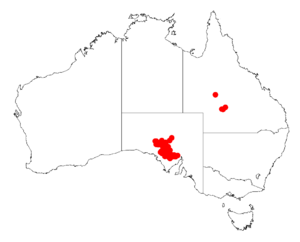Granite bush facts for kids
Quick facts for kids Granite bush |
|
|---|---|
| Scientific classification | |
| Genus: |
Acacia
|
| Species: |
tarculensis
|
 |
|
| Occurrence data from AVH | |
Acacia tarculensis, often called the granite wattle, granite bush, or steel bush, is a special kind of shrub. It belongs to the Acacia family. This plant is found naturally in the south central parts of Australia.
About the Granite Bush
This shrub is usually dense and spreads out. It can grow to be about 1 to 3 meters (3 to 10 feet) tall. Sometimes it has a rounded top, and other times it's flatter.
Like most Acacia plants, it doesn't have regular leaves. Instead, it has what are called phyllodes. These are flattened leaf stems that act like leaves. The phyllodes are tough and grey-green. They are shaped like an oval, about 2.5 to 5.5 centimeters (1 to 2 inches) long. They are 7 to 14 millimeters (about 0.3 to 0.5 inches) wide.
When the phyllodes are young, they have golden or silvery hairs. They also have many thin lines, called nerves, running through them. One to three of these nerves are a bit clearer than the others.
The granite bush usually blooms between May and August. But it can also flower at other times if it rains a lot. Its flowers grow in simple groups, either alone or in pairs. These groups are found where the leaf stems meet the main branch. The flower spikes are shaped like cylinders and are 15 to 25 millimeters (about 0.6 to 1 inch) long. They have bands of golden flowers.
After the flowers, soft, woody seed pods grow. These pods are narrow and oblong. They are barely raised over the seeds inside. The pods are curved and can be up to 9 centimeters (about 3.5 inches) long. They are 10 to 12 millimeters (about 0.4 to 0.5 inches) wide. The edges of the pods are thicker. The seeds inside are dull brown and broadly oval. They are about 7.5 millimeters (0.3 inches) long. Each seed has a small, fleshy cap called an aril at one end.
How it Got its Name
The granite bush was first officially described in 1912. A botanist named John McConnell Black gave it its scientific name. He wrote about it in a scientific paper.
For a short time in 2003, another scientist, Leslie Pedley, reclassified it. He called it Racosperma tarculense. But in 2006, it was moved back to the Acacia family.
The second part of its scientific name, tarculensis, comes from the town of Tarcoola. This is where the first sample of the plant was collected. A person named J.W. Mellor found it there in 1912.
Where the Granite Bush Lives
The granite bush is a plant that is endemic to a specific area. This means it is only found naturally in southern parts of central South Australia. You can find it from the northern Eyre Peninsula up to areas west of the Gawler Ranges. It also grows just north of Tarcoola.
This plant usually lives on rocky hillsides and ridges. These areas are made of granite rock. It grows as part of open shrublands or low woodlands.
The granite bush often grows near other Acacia species. These include Acacia aneura, Acacia cibaria, and Acacia papyrocarpa. It prefers shallow, firm, loamy soils. It also likes alkaline red soils and brown soils that contain lime. These areas usually get about 200 to 350 millimeters (8 to 14 inches) of rain each year.

